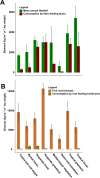Global distribution of soil fauna functional groups and their estimated litter consumption across biomes
- PMID: 36253487
- PMCID: PMC9576680
- DOI: 10.1038/s41598-022-21563-z
Global distribution of soil fauna functional groups and their estimated litter consumption across biomes
Abstract
Soil invertebrates (i.e., soil fauna) are important drivers of many key processes in soils including soil aggregate formation, water retention, and soil organic matter transformation. Many soil fauna groups directly or indirectly participate in litter consumption. However, the quantity of litter consumed by major faunal groups across biomes remains unknown. To estimate this quantity, we reviewed > 1000 observations from 70 studies that determined the biomass of soil fauna across various biomes and 200 observations from 44 studies on litter consumption by soil fauna. To compare litter consumption with annual litterfall, we analyzed 692 observations from 24 litterfall studies and 183 observations from 28 litter stock studies. The biomass of faunal groups was highest in temperate grasslands and then decreased in the following order: boreal forest > temperate forest > tropical grassland > tundra > tropical forest > Mediterranean ecosystems > desert and semidesert. Tropical grasslands, desert biomes, and Mediterranean ecosystems were dominated by termites. Temperate grasslands were dominated by omnivores, while temperate forests were dominated by earthworms. On average, estimated litter consumption (relative to total litter input) ranged from a low of 14.9% in deserts to a high of 100.4% in temperate grassland. Litter consumption by soil fauna was greater in grasslands than in forests. This is the first study to estimate the effect of different soil fauna groups on litter consumption and related processes at global scale.
© 2022. The Author(s).
Conflict of interest statement
The authors declare no competing interests.
Figures





References
-
- Frouz J. Effects of soil macro- and mesofauna on litter decomposition and soil organic matter stabilization. Geoderma. 2018;332:161–172. doi: 10.1016/j.geoderma.2017.08.039. - DOI
-
- Lavelle P, et al. Soil function in a changing world: The role of invertebrate ecosystem engineers. Eur. J. Soil Biol. 1997;33:159–193.
Publication types
MeSH terms
Substances
LinkOut - more resources
Full Text Sources

